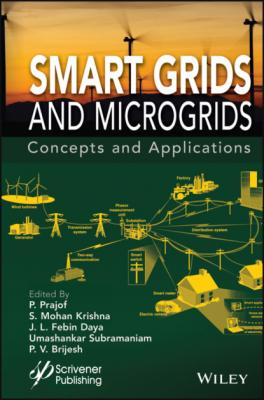Smart Grids and Micro-Grids. Umashankar Subramaniam
Чтение книги онлайн.
Читать онлайн книгу Smart Grids and Micro-Grids - Umashankar Subramaniam страница 16

Figures 1.4 and 1.5 represent the P-V and I-V characteristics of solar PV panels such as KD245GX and SHELL SP70 under varying irradiance from 200 to 1000 W/m2 and temperature of 25 to 50°C, repectively. The results have shown that the decrease in the solar irradiance reduces the maximum power output from the PV panel and increases the power loss due to increase in the shunt resistance. However, the increase in temperature has minimum effect on shunt resistance and almost maintains the output power from the panel. On comparing the results obtained from both N-R and G-S methods, the maximum power exhibits excellent agreement with good accuracy by the NR approach under varying irradiance and temperature.
1.4.2 Experimental Results
An experimental setup was made to test the effectiveness of NR technique to estimate the parameters of PV module under dynamic environmental conditions. The experimental setup uses HST60FXXXP, 250 W PV panel with the following specification given in Table 1.6 as shown in Figure 1.6(a). A solar system analyzer was used to record the various circuit parameters of PV panel and the data recorded for the irradiance of 929 W/m2 with the operating temperature of 36.9°C is given in Table 1.5. Figure 1.6(b) and 1.6(c) represents the I-V and P-V characteristics of PV panel experimental results compared with the simulation results obtained from NR technique for the irradiance of 929 W/m2 with the operating temperature of 36.9°C as presented in Table 1.7. The results have highlighted that the simulated I-V and P-V characteristics have good agreement with experimental characteristics.
1.4.3 Comparative Analysis
The parameters of SDM are obtained using various analytical and heuristic based optimization techniques in the literature. Tables 1.8 and 1.9 presents the results of maximum voltage, current and power obtained at the MPP of SDM solar PV using Sandia model, solution using simulation of equivalent parameters, adaptive neuro-fuzzy inference system (ANFIS), GS and NR method. On calculating the absolute error (AE) of maximum power (70 W) obtained at STC for Shell SP70 using various techniques presented, the AE is minimum (0.112) using NR technique compared to other approaches. Similarly, the parameter estimation of SDM were solved by calculating the root mean square error or AE using various heuristic optimization technique like adaptive differential evolution algorithm [3], Flower Pollination Algorithm [11], slime mould optimization algorithm [7] and so on. However, these optimization techniques are stochastic and implementation of these techniques in real-time requires large number of iteration for its convergence which is not suitable for MPP estimation.
Figure 1.4 Simulation results of KD245GX (a) P-V characteristics (b) I-V characteristics.
Figure 1.5 Simulation results of SHELL SP70 (a) P-V characteristics (b) I-V characteristics.
Table 1.6 Experimental data observed from the HST60FXXXP PV module.
| T (°C) | G (W/m2) | A | Rse | Rsh | ILG | Isat | Vmpp | Impp | Pmpp |
| 36.9 | 929 | 0.8055 | 0.2716 | 7.09E4 | 7.9896 | 1.62E-11 | 30.001 | 4.7991 | 147.33 |
Figure 1.6 (a) Experimental set up of HST60FXXXP 250 W SPV panel (b) Simulated and experimental I-V curves (c) Simulated and experimental P-V curves.
Table 1.7 I-V and P-V data obtained from NR simulation and experimental set up of HST60FXXXP 250 W SPV Panel.
| NR- simulation results | Experimental results | ||||
| V(V) | I(A) | P(W) | V(V) | I(A) | P(W) |